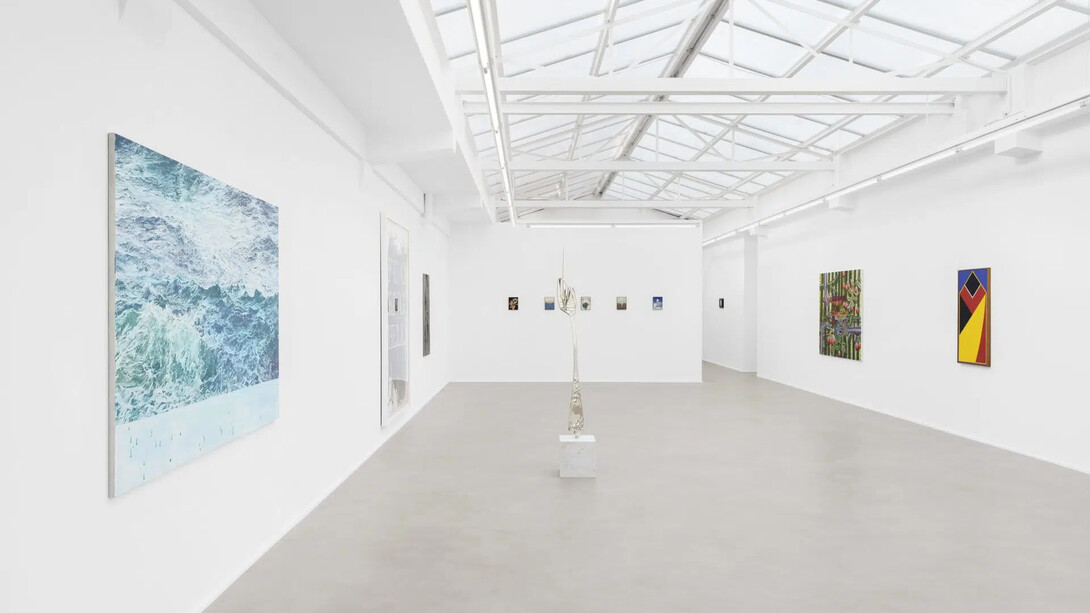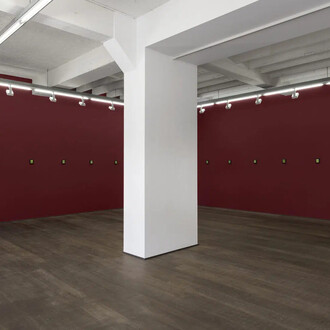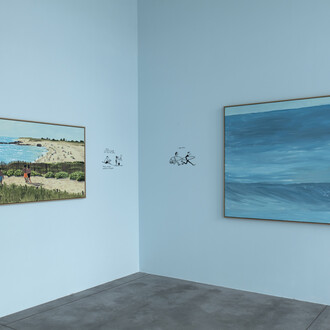L’union fait la force, marks a historic moment: for the first time, the gallery is bringing together all nine Belgian artists it represents.
Through this project, we wanted to strongly affirm just how deep and lasting our commitment to the Belgian art scene truly is. Its diversity, of generations, of approaches, of regions, and of visual languages is embodied here in a constellation of artists whose unique practices engage in dialogue, confront one another, and mutually enrich each other.
Over the years, beyond professional collaboration, a true community has formed: a family of artists and friends, united by a shared ambition and a bond nurtured over time and through the works they create.
The title L’union fait la force is not just a motto: it expresses the founding spirit of this collective endeavor. It speaks to the energy shared between gallerist and artists, the belief that it is together that we spark new momentum, that we amplify and carry further the voice of Belgian art.
Marcel Berlanger’s work blends painting, photography and stage design, exploring the figure’s construction and deconstruction within the image. Berlanger is best known for his unique paintings on self-developed supports of glass fiber and polyester. These unique surfaces give his figurative paintings a striking grid pattern, making them resemble pixelated photographs.
His work was shown in group exhibitions in Musée van Buuren, Brussels, Belgium; The Belgian Senate, Brussels, Belgium; La Maison Particulière, Brussels, Belgium; BPS22, Charleroi, Belgium; MAC’s, Hornu, Belgium and IKOB Museum of Contemporary Art, Eupen, Belgium.
Born as Abraham van den Boogaart, Bram Bogart began as a house painter before briefly studying at the Fine Arts Academy in The Hague to avoid conscription. Over a long career, he moved from figuration through cubism and gestural abstraction to the richly textured, sculptural paintings for which he is best known. Focused on the materiality of paint, Bogart developed a dense, tactile medium combining pigments, oils, water, and other materials, creating bold abstract works that merge gesture with mass in a powerful, three-dimensional presence.
His work has been exhibited in many institutions and galleries, and is held in numerous public collections such as Museum Boijmans Van Beuningen, Rotterdam, The Netherlands; Gemeentemuseum Den Haag, The Hague, The Netherlands; Museum Voorlinden, Wassenaar, The Netherlands; Musée royaux des Beaux-Arts, Brussels, Belgium; Musée d’Ixelles, Brussels, Belgium; S.M.A.K., Ghent, Belgium; KMSKA, Antwerp, Belgium; MUDAM Luxembourg, Luxembourg; Moderna Museet, Stockholm, Sweden and TATE Modern, London, UK.
Wim Delvoye was able to establish himself as one of the most controversial artists of his time with a number of canonical works, including the infamous Cloaca (2000). One can call Wim Delvoye the businessman-entrepreneur that remains firmly in control. These artists are distinguished by their unique ability to react to contemporary political, economic, and cultural paradigms, particularly those that underpin the art world and the art market. His art is often a combination of craftsmanship and the most sophisticated industrial manufacturing techniques.
Wim Delvoye had solo exhibitions at the Musée du Louvre, Paris, France; Musée Tinguely, Basel, Switzerland; Peggy Guggenheim Collection, Venice, Italy; and many more. Works by Wim Delvoye are included in numerous public collections, such as Guggenheim New York, NY, USA; SMAK, Ghent, Belgium; Stedelijk Museum, Amsterdam, The Netherlands; Centre Georges Pompidou, Paris, France.
European by descent and African by birth, Kendell Geers defines himself as animist, mystic, shaman, alchemist, punk, and poet. A committed anti-apartheid activist from a young age, he developed a psycho-socio-political practice where ethics and aesthetics are inseparable. His work challenges art history, disrupts power structures, and transforms belief systems into aesthetic codes by working across media including found objects, neon, performance, and video.
Recent solo and group exhibitions were held at BOZAR/Centre for Fine Arts, Brussels, Belgium; Fondazione Berengo Art Space, Venice, Italy and many more. Kendell Geers is included in numerous museum and public collections such as Cleveland Museum of Art, Cleveland, USA; Zeitz MOCA, Cape Town, South Africa, BPS22, Charleroi, Belgium; Centre Pompidou, Paris, France;
Sanam Khatibi’s work explores paradoxes: domination and submission, violence and sensuality, instinct and reason, blurring boundaries between power and vulnerability. Her art delves into fear and desire, often symbolized by snakes, creatures that both fascinate and unsettle her. Human and animal figures appear in states of metamorphosis, reinforcing a visceral, organic feel. Her canvases balance vast, enveloping landscapes with tiny, intricate details like porcelain figurines and insect remains, creating a hypnotic interplay of scale and emotion. Her work consists of paintings, embroideries, tapestries, and sculptures.
She has recently had solo exhibitions at the Groeninge Museum in Bruges, Belgium; Kunsthal Gent, Ghent, Belgium; BPS22, Charleroi, Belgium and has shown in group exhibitions at Kunstverein Dresden, Dresden, Germany; Centraal Museum, Utrecht, The Netherlands. Her work is included in public collections such as Centraal Museum, Utrecht, The Netherlands; Belfius Art Collection, Belgium; The Norton Museum, West Palm Beach, USA and The Al Thani Collection, Paris, France.
Thomas Lerooy’s work is defined by dualities, at once attractive and unsettling, humorous and serious, intimate and grotesque. Whether drawing, sculpting, or painting, he explores the limits of both medium and subject, using familiar motifs that he distorts to provoke and challenge. Known for his sculptures and drawings, Lerooy turned to painting in response to the constraints of his previous techniques.
His work has been the subject of several institutional solo exhibitions in recent years, including Behind the Curtain at the Royal Museums of Fine Arts of Belgium, Brussels, Belgium; Vanity Fair at Gaasbeek Castle, Gaasbeek, Belgium; Playground in Museum Dhondt-Dhaenens, Deurle, Belgium; and Beauty in the shadow of the stars at the Petit Palais, Musée des Beaux-Arts de la Ville de Paris, Paris, France. Lerooy’s work is included in public institutions such as TANK Museum, Shanghai, China; the Musée National d’Art Moderne – Centre Pompidou, Paris, France; Belfius Art Collection, Brussels, Belgium.
Whenever Tom Poelmans starts to paint, he is flooded with a rather innocent and spontaneous thought that he can freely paint whatever he wants, through his floating brushstrokes on the canvas. Each of his creation inevitably faces that illusion of free will that he himself claims. It is a journey into the author’s mind, based on infinite possibilities, a process that begins with a drawing and then ends with a decidedly unpredictable pictorial image. His work shows an exceptional and intricate heterogeneity, with a dreamlike vocation rich in symbols, allegories and metaphors.
His work has recently been exhibited at Anna Zorina Gallery, New York, NY USA; Ballroom Project, Antwerp, Belgium; Jack Barrett Gallery, East Hampton, New York, NY USA; The Cabin, Los Angeles, CA USA; Tatjana Pieters, Ghent, Belgium; Garage, Mechelen, Belgium and Be-Part, Waregem, Belgium.
Lisa Vlaemminck’s work explores the boundaries between abstraction and figuration, blending visceral imagery with psychedelic compositions. By isolating and magnifying everyday objects like torsos, nails, or food she creates a surreal tension between the familiar and the uncanny. Her vibrant, often synesthetic canvases reflect the seductive contradictions of consumerism, evoking both beauty and the grotesque.
Her work was included in several personal and group exhibitions at BOZAR, Brussels, Belgium; Triennial Bruges, Belgium; Tatjana Pieters, Ghent, Belgium; Roger Raveel Museum, Zulte and KIOSK, Ghent, Belgium and more. Her work is included in the collection of the Ministry of Foreign Affairs, Belgium; Collectie Vlaamse Gemeenschap, Belgium; M Leuven, Belgium and FRAC Normandie, Caen, France.
For over 60 years, Léon Wuidar has been a key figure in Belgian concrete abstraction. Long under-recognized, he gained renewed international attention in his 80s. Inspired by his childhood in Liège, architecture, and his close collaboration with architect Charles Vandenhove, Wuidar worked on major in situ projects like the Sart Tilman Hospital. His precise, disciplined paintings combine geometry, color, and subtle humor, meticulously composed forms framed simply in wood, reflecting a lifelong commitment to harmony and balance.
His works has been exhibited at IKOB, Eupen, Belgium; White Cube, Hong Kong, China and White Cube, London, UK; MAC’s, Grand-Hornu, Belgium; Museum Haus Konstruktiv, Zürich, Switzerland and many more. His work is included in Centre national d’art et de culture Georges-Pompidou, Paris, France; FRAC Normandie, Caen, France; Musée Royal des Beaux-Arts, Brussels, Belgium.
















